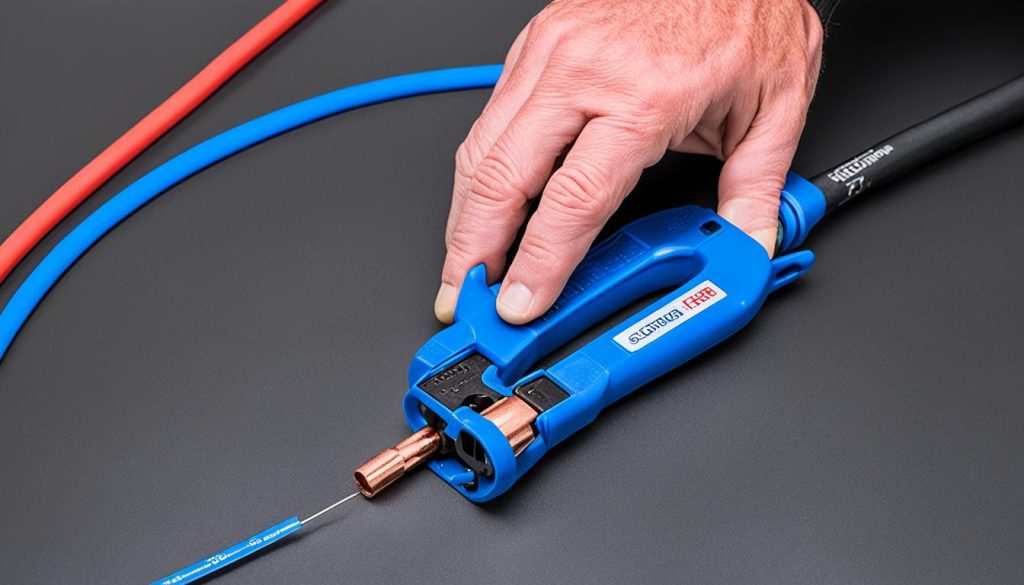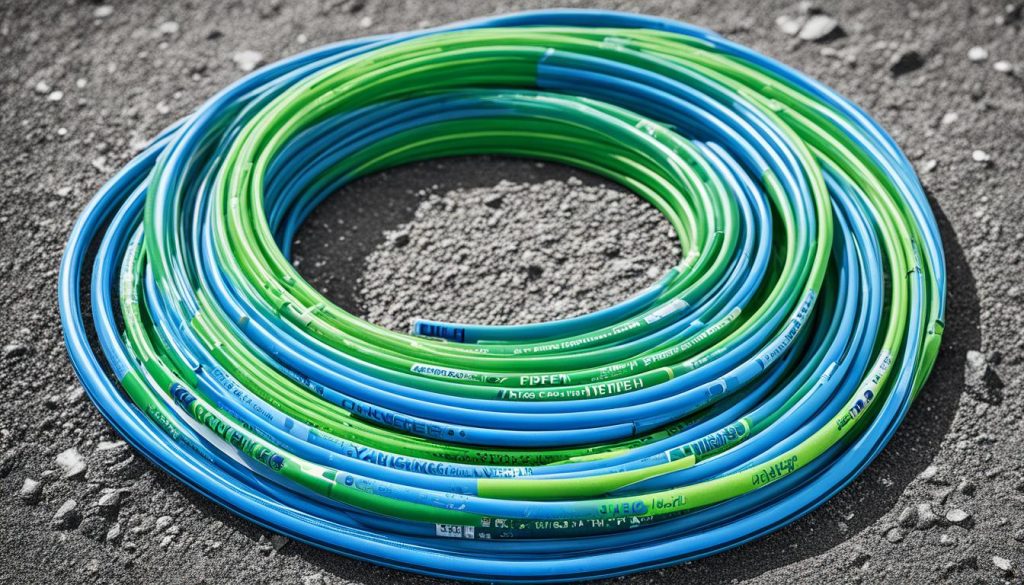Understanding Red and Blue Water Lines Setup
Did you know that red and blue water lines, also known as PEX tubing, have become the go-to choice for water pipe installation in many modern homes? This shift from traditional copper pipes has been fueled by the numerous advantages offered by PEX tubing, including lower cost, quicker installation, freeze resistance, and minimal risk of corrosion and leakage.
PEX tubing, an abbreviation for cross-linked polyethylene, has revolutionized the plumbing industry with its ease of use and durability. The color-coded nature of red and blue PEX tubing makes it even more appealing, allowing for easy identification of hot and cold water lines.
Key Takeaways:
- Red and blue water lines, or PEX tubing, offer numerous benefits compared to copper pipes.
- PEX tubing is cost-effective, quick to install, and resistant to freezing and corrosion.
- There are three main types of PEX tubing: PEX-A, PEX-B, and PEX-C, each with its own advantages.
- PEX tubing can be connected using various methods, including copper crimping, expansion connections, stainless steel clamps, compression fittings, and push-fit connections.
- While PEX tubing has many advantages, it is not suitable for outdoor use and currently cannot be recycled.
The Benefits of PEX Tubing
PEX tubing is revolutionizing the world of building technology, offering a cost-effective and efficient alternative to traditional copper pipes. Its numerous advantages make it an attractive choice for residential plumbing systems. Let’s examine the key benefits of using PEX tubing:
- Cost-effective: PEX tubing is a budget-friendly option that provides long-term savings. Its initial cost is significantly lower than copper pipes, and its stable pricing ensures a more predictable investment.
- Quick Installation: With its straightforward installation process, PEX tubing saves both time and labor costs. Its flexibility allows for easy maneuvering around obstacles, making it a preferred choice for contractors and DIY enthusiasts.
- Resistance to Freezing: Unlike copper pipes, PEX tubing is highly resistant to freezing temperatures. Its superior flexibility minimizes the risk of pipe bursts, ensuring a reliable water supply even in harsh winter conditions.
- Seamless: The seamless nature of PEX tubing eliminates the possibility of leakage. This ensures efficient water flow and prevents unnecessary water wastage and potential water damage in your home.
- Flexibility: PEX tubing’s flexibility reduces the need for additional joints and fittings. This not only simplifies the installation process but also reduces the likelihood of leaks, enhancing the overall reliability of your plumbing system.
https://www.youtube.com/watch?v=nAwE7IU2PO8
With these advantages, it is clear why PEX tubing is gaining popularity in the construction industry. Its cost-effectiveness, quick installation, resistance to freezing, seamless design, and flexibility make it the ideal choice for modern plumbing systems. Whether you are building a new home or renovating an existing one, PEX tubing offers a reliable and efficient solution for all your plumbing needs.
The Types and Uses of PEX Tubing
PEX tubing is a versatile option for various plumbing needs, including water supply systems and radiant floor heating. It is available in three main types: PEX-A, PEX-B, and PEX-C, each with its own unique characteristics and advantages.
1. PEX-A
PEX-A is the most flexible type of PEX tubing. Its high flexibility makes it suitable for a wide range of applications, including water supply systems and radiant floor heating. The flexibility of PEX-A allows for easier installation around tight corners and curves, minimizing the need for additional fittings and reducing the risk of leaks.
2. PEX-B
PEX-B is slightly stiffer than PEX-A but still offers significant flexibility. It is commonly used in residential plumbing due to its ease of installation and durability. PEX-B tubing is compatible with various connections and fittings, making it a reliable choice for water supply systems and other plumbing applications.
3. PEX-C
PEX-C is the least flexible type of PEX tubing but is the most economical option. It is commonly used for minor repairs and installations where flexibility is not a major concern. PEX-C tubing is a cost-effective choice for applications that do not require extensive bending or maneuvering.
In addition to their individual characteristics, all types of PEX tubing can be used for both hot and cold water lines. This makes PEX tubing a versatile choice for residential plumbing systems, offering convenience and flexibility for various applications.
When selecting the appropriate type of PEX tubing for your project, consider factors such as the level of flexibility required, the specific plumbing needs, and your budget. Consulting with a professional plumber or plumbing supplier can help ensure that you choose the right type of PEX tubing for efficient and reliable water line installation.
Connecting and Installing PEX Tubing
When it comes to connecting and installing PEX tubing, there are various methods available depending on the type of fitting and tool you prefer. Here are some common options:
Copper Crimping
Copper crimping uses copper crimping rings and a crimping tool to create secure connections. This method is reliable and widely used, providing watertight joints.
Expansion Connections
For expansion connections, a PEX expander tool is utilized. This tool expands the PEX tubing, allowing it to fit over the fittings snugly. As the tubing contracts, it forms a strong and reliable connection.
Stainless Steel Clamps
Stainless steel clamps, also known as PEX cinch or clamp rings, are secured using a ratchet clamping tool. This method is quick and straightforward, offering secure connections without the need for special tools.
Compression Fittings
Compression fittings involve a threaded brass nut and compression ring. By tightening the nut, the compression ring creates a tight seal, ensuring a leak-free connection. This method is commonly used for transitioning between PEX and other types of pipes.
Push-fit Connections
Push-fit connections, also known as push-to-connect or quick-connect fittings, offer a convenient and tool-free installation process. The fittings have built-in O-rings that create a tight seal when the PEX tubing is inserted.
These various methods provide reliable and watertight connections, allowing for seamless installation of PEX tubing in residential plumbing systems.
The Advantages and Considerations of PEX Tubing
PEX tubing offers several advantages over traditional materials, making it a popular choice for residential plumbing systems. Let’s explore the benefits of PEX tubing and important considerations when using it.
Advantages of PEX Tubing:
- No Soldering: Unlike copper pipes that require soldering for connections, PEX tubing allows for simple and hassle-free installation. This eliminates the need for open flames, making it a safer option.
- Freeze-Resistant: PEX tubing is highly resistant to freezing, minimizing the risk of pipe bursts in cold temperatures. Its flexibility helps absorb expansion and contraction caused by freezing water, ensuring reliable performance even in harsh winter conditions.
- Corrosion-Resistant: Unlike copper pipes that can corrode over time, PEX tubing is corrosion-resistant, providing a clean and contamination-free water supply. This eliminates the potential health risks associated with corroded pipes and ensures the delivery of high-quality potable water.
- Noiseless Flow: PEX tubing offers a noiseless flow, preventing the annoying “water hammer” noise commonly associated with metal piping. The smooth interior surface of PEX tubing minimizes turbulence, ensuring a quiet and peaceful water flow throughout your home.
- UV Degradation: While PEX tubing offers many advantages, it is not suitable for outdoor use due to its vulnerability to UV degradation. Exposure to sunlight can cause PEX tubing to deteriorate and lose its structural integrity. Therefore, it is important to use PEX tubing exclusively for indoor plumbing applications.
- Recyclability: Currently, PEX tubing is not widely recyclable, which poses a concern for environmental sustainability. It is important to consider the environmental impact when selecting plumbing materials and explore eco-friendly alternatives when possible.
Considerations when Using PEX Tubing:
While PEX tubing offers numerous advantages, there are a few considerations to keep in mind:
- Proper installation techniques: Ensure that PEX tubing is installed following manufacturer guidelines and local plumbing codes to maximize its performance and longevity.
- Pipe sizing and compatibility: Select the appropriate pipe diameter and fittings to ensure adequate water flow and compatibility with existing plumbing systems.
- Indoor use only: Avoid using PEX tubing for outdoor plumbing applications, as it is not designed to withstand UV exposure and can degrade over time.
- Regular inspections: Periodically inspect PEX tubing for any signs of damage, such as cracks or leaks, to address potential issues early and prevent water damage.
| Advantages | Considerations |
|---|---|
| No Soldering | Proper installation techniques |
| Freeze-Resistant | Pipe sizing and compatibility |
| Corrosion-Resistant | Indoor use only |
| Noiseless Flow | Regular inspections |
| UV Degradation | |
| Recyclability |
Choosing PEX Tubing for Efficient Water Line Setup
When it comes to setting up water lines, selecting the right PEX tubing is crucial. There are a few key factors to consider to ensure a successful installation. First, think about the intended use and compatibility with your existing plumbing system. PEX tubing is widely available at local hardware stores and online retailers, making it accessible for DIY plumbing projects.
One of the advantages of PEX tubing is its flexibility. This feature allows for easy installation and maneuverability in tight spaces. You can easily bend and curve the tubing to fit your specific needs, simplifying the entire process.
Another important consideration is the pipe diameter. Choosing the appropriate size, such as 1/2-inch or 3/4-inch, ensures adequate water flow for your intended use. This is crucial to avoid any restrictions or issues with water pressure in your plumbing system.
Lastly, the color-coding of red and blue PEX tubing is a notable benefit. The distinct colors make it easy to identify hot and cold supply lines, simplifying installation and facilitating future repairs. This color-coding system saves time and minimizes confusion, ensuring that your plumbing setup is efficient and well-organized.
- Investing Wisely: How Windows & Doors in Boost Property Value and Financial Health - April 24, 2025
- The Financial Impact of Personal Injuries: Why Legal Help Matters for Business Owners - April 16, 2025
- The Hidden Financial Costs of Domestic Assault: What Business Owners Need to Know - April 16, 2025














